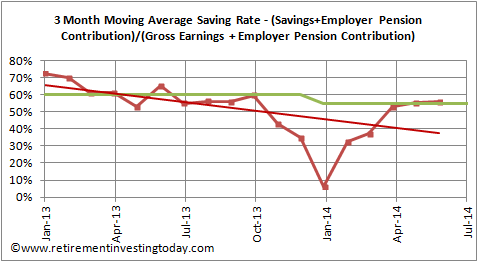The June distribution laggards have now paid up so let’s take a pause to validate whether the tools and techniques from this site actually work in the real world. This is achieved by my living the Save Hard, Invest Wisely, Retire Early mantra. I'm a real life guinea pig putting my own money where my mouth is. A mistake in one of my concepts could affect not only me but also my family greatly.
In addition this half year saw HM Revenue and Customs change tune and make some aggressive demands for a tax error that they made in the 2012/13 tax year which enabled me to regularly save in the high sixties/low seventies.
Saving hard first half score: Conceded Pass. Without the HMRC recovery, which I’d already saved in previous periods, the savings rate would have been held. Since sorting this the new 55% savings rate has been sustained.
SAVE HARD
It’s now my sixth year of aiming to save 60% of my earnings, where earnings are defined as my gross (ie before tax) earnings plus any employee pension contributions. Changes over the past six months mean that this target is now out of reach and a revision to a 55% target is needed. Before you start flaming me I confirm that I haven’t been a hypocrite and started a consumerist lifestyle. Instead the change has been caused by a healthy salary increase which is taxed at the 40% Higher Rate plus 2% National Insurance making 58% the most I could save from this new money. Additionally, to keep my better half and I on the same financial independence trajectory this increase means I now need to cover all of the household costs as well as direct some of my savings to my better half’s investment portfolio.In addition this half year saw HM Revenue and Customs change tune and make some aggressive demands for a tax error that they made in the 2012/13 tax year which enabled me to regularly save in the high sixties/low seventies.
Click to enlarge
Saving hard first half score: Conceded Pass. Without the HMRC recovery, which I’d already saved in previous periods, the savings rate would have been held. Since sorting this the new 55% savings rate has been sustained.


